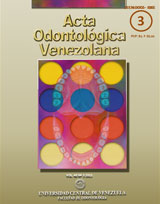EFECTO DEL CONSUMO DE ANTICONCEPTIVOS ORALES EN EL FLUJO SALIVAL NO ESTIMULADO, PH Y CAPACIDAD BUFFER
Keywords:
saliva, Flujo salival no estimulado, pH salival, capacidad buffer, anticonceptivos orales, not stimulated salivary flow, salivary pH, buffer capacity, oral contraceptivesAbstract
INTRODUCCION: La saliva, un elemento esencial en la preservación de salud oral, puede verse alterada por diversos factores, como el consumo de fármacos, en cuanto al flujo, pH o capacidad buffer, constituyendo un factor predisponente a diversas patologías (1). OBJETIVO: Comparar el flujo salival no estimulado, pH y capacidad buffer entre consumidoras y no consumidoras de anticonceptivos orales combinados. MATERIALES Y MÉTODOS. Cincuenta y seis mujeres sanas, entre 21 y 26 años de edad, con bajo riesgo cariogénico, dividida en dos grupos, consumidoras y no consumidoras de anticonceptivos orales. Para determinar el flujo salival no estimulado, se tomó una muestra de saliva durante 15 minutos. Para determinar los pH se utilizó un potenciómetro (PL-600Lab PH meter) y para determinar capacidad buffer se utilizó el método de Ericsson. Para analizar la significancia estadística de las diferentes pruebas se realizó la prueba U Mann-Whitney utilizando el software SPSS versión 14.0. RESULTADOS: El promedio de flujo salival no estimulado observado en este estudio, es mayor entre consumidoras de anticonceptivos orales, con un p<0.005. En cuanto a capacidad buffer, se obtuvieron valores levemente superiores en el grupo consumidor, mientras que los valores de pH resultaron similares entre ambos grupos. CONCLUSION: El flujo salival no estimulado se ve aumentado en las consumidoras de anticonceptivos orales combinados, mientras que la capacidad buffer presenta un incremento no significativo, mientras que el pH salival arroja valores similares para ambos grupos.
ABSTRACT.
INTRODUCTION: Saliva is an essential element in oral health preservation and its pH, buffer capacity and flow rate, have a fundamental role. These factors may be altered by, among others, drug consumption which predisposes to several diseases (1). OBJECTIVE: To compare the non-stimulated salivary flow rate, pH and buffer capacity between patients under Oral contraceptives medication and not taking any medication. MATERIALS AND METHODS: Fifty six healthy women, aged 21 to 26 years, with low cariogenic risk, divided into two groups: under oral contraceptives medication and without medication. To determine the non-stimulated salivary flow rate, was taken a saliva sample during 15 minutes. To determine the pH, was used a potentiometer (PL 600Lab PH-meter) and buffer capacity was measured by Ericsson's method. Mann-Whitney test was performed using SPSS software version 14.0 to determine statistical significance. RESULTS: Mean of stimulated salivary flow rate is not statistically significantly in subjects under oral contraceptives medication (p <0.005). Buffer capacity showed slightly higher values in study group, while the pH values were similar in study and control groups. CONCLUSION: The stimulated salivary flow rate is not increased by consuming the Oral contracetives, the salivary pH shown similar values for both groups, and finally, the salivary buffer capacity, shown increased in the consumer group, however, it does not statistically significant.


